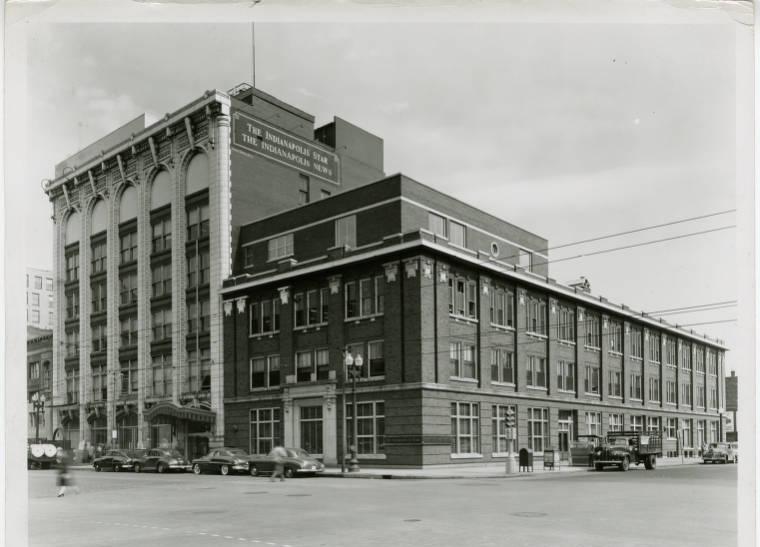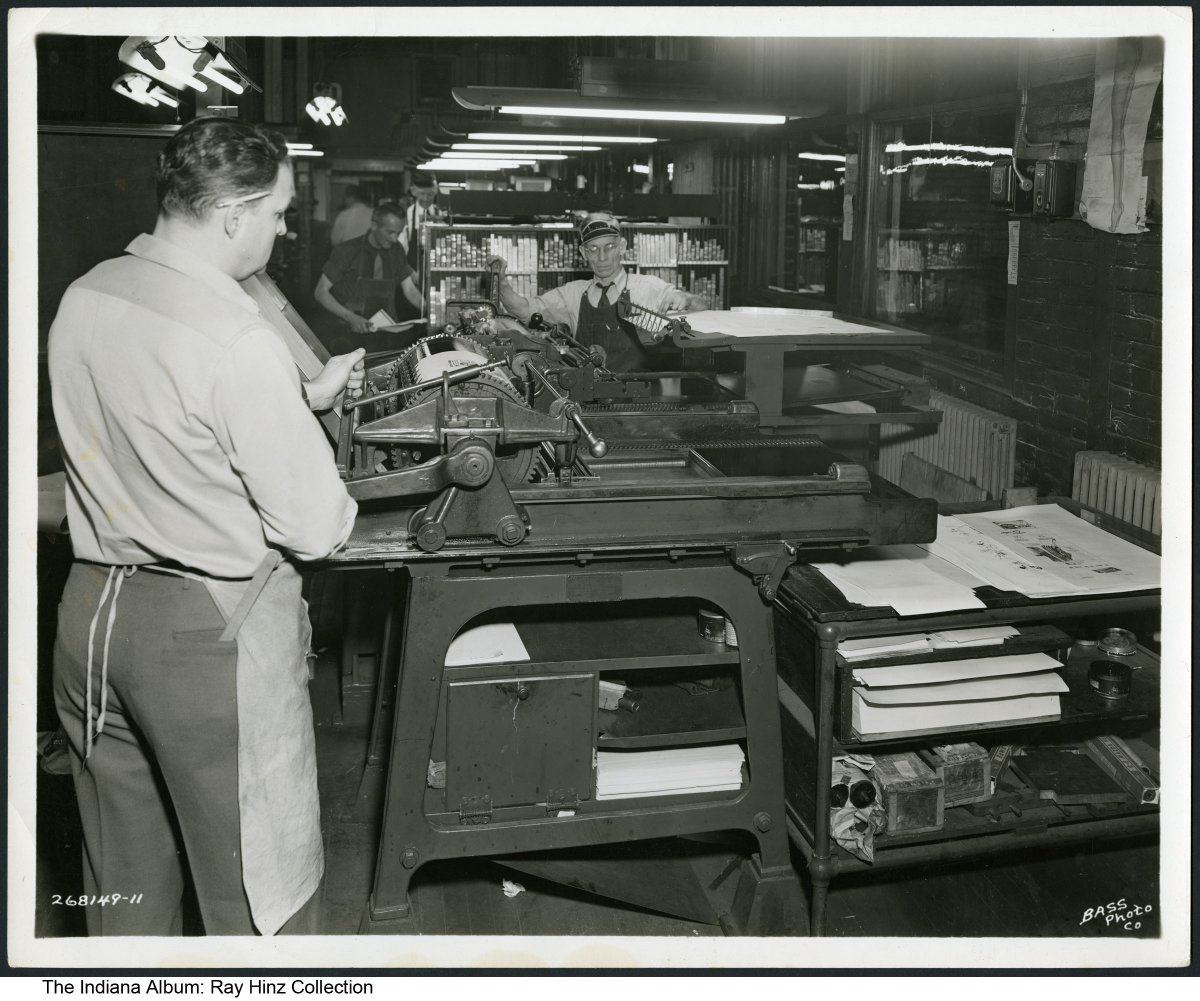The debuted June 6, 1903, as a seven-days-a-week newspaper, the brainchild of Muncie industrialist George McCulloch. To launch his newspaper, the Muncie industrialist paid a hot-air balloonist $650 to drop a half-million red cardboard stars on Indianapolis. The first two days of the Star’s existence McCulloch distributed 50,000 free copies of the one-cent newspaper, six months later paid circulation was over 70,000.

At a time when most of the other morning newspapers were backed by political parties, the billed itself as “an independent newspaper for the people.” The and the , both morning papers, had been the voices of the Republican and Democrat parties, respectively, since Indiana’s pioneer days. The , an independent 2-cent afternoon paper, was first published in 1869 and continued to flourish at the turn of the 20th century. The and the were other local papers, as well. The competition was fierce for both readers and advertising.
When first published, the operated out of a Victorian-style house that stood at 119-121 E. Ohio Street. McCulloch oversaw the newspaper’s move to a four-story building on Monument Circle. Although paid circulation grew in exponential proportions during the first six months of its operation, McCulloch’s one-cent price drained his finances, and he sold the paper in 1904 to tin-plate millionaire Daniel G. Reid of Richmond, who hired Chicago Post publisher John Shaffer to the same position at the Star.

The challenged the two older morning papers, the and the . Just a year after the ‘s debut, it had absorbed the . In 1907 the bought the Sunday and the daily ceased publication, leaving the the city’s lone morning paper. At this time, the moved to the corner of New York and Pennsylvania streets. Local coverage of the news was enhanced with imagery after the Star hired a photographer in 1910.
Shaffer emerged as the major stockholder during a 1908 court battle and served as editor and publisher from 1911 until his death on October 5, 1943. During his tenure, the paper became known as “the businessman’s paper” and also led campaigns for social and economic reforms. Among other early Star employees were , a woman investigative journalist, and , a political columnist who wrote “The Day in Indiana,” a page-one column, until his death in 1954. Hoosier author also was a frequent contributor to the Sunday Star.
, newspaper and radio station owner, fought off competitors to buy the Star and the Muncie Star from the Shaffer estate for $2.35 million in April 1944. The publisher took on the Star’s larger afternoon rivals, the Indianapolis News and the Indianapolis Times. Pulliam took steps to enhance the newspaper through feature sections. He began a women’s section, built up the sports page, and on January 12, 1947, started the Indianapolis Star Magazine as part of the Sunday newspaper. The latter feature ceased publication in 1985 after it failed to attract advertising. He also hired the Times’ popular columnist, . Pulliam never shied from controversy, writing impassioned front-page editorials that made his paper popular with readers and an exciting place to work.
By 1947, the Star was dominating the city’s other newspapers, leading the News by a margin of 177,390 to 171,000. The Star has been the city’s and state’s largest circulation newspaper since. By then, the News, owned by the family, was for sale. In another battle, Pulliam dueled with Times publisher for the rights to own it. In August 1948, Pulliam won the battle, purchasing the News for $4 million. He remained its publisher until his death in 1975. During the first year of ownership, he consolidated the mechanical and commercial departments of the Star and the News to reduce operating expenses, but the editorial staffs remained separate and competitive. Pulliam also created Indianapolis Newspapers Inc. before the year’s end.

Though the News moved into the Star building in 1950, the two newspapers continued to operate independently with their own staff, tradition, and character. In July 1967, land at 329 N. Pennsylvania became the site of a three-story addition to the Star-News Building, which was meant to house the newspapers’ combined mechanical departments. Overhead and underground connections linked the two buildings.
When Eugene C. Pulliam died in 1975, local control of the paper continued with his son, succeeding him as publisher. The Pulliam family-owned newspapers in Indiana and in Arizona, operating then under the corporate name Central Newspapers Inc., which began trading publicly in September 1989. Eugene S. helped continue the Star‘s circulation growth in the city, and by 1990 the morning newspaper was at 228,565 daily and the Sunday issue at 411,377.

As investigative journalism increased in the 1970s, the Star won its first in 1975 for a series that began in February 1974, on Indianapolis police corruption. The Star’s tradition for local journalism continued with writer Tom Keating who for 14 years won a loyal following with his daily columns about the city’s people before he left the Star in 1985. The newspaper’s second Pulitzer Prize came in 1991 for a June 1990, series on Indiana doctors who continued to practice despite losing multiple malpractice lawsuits and receiving no punishment.
On January 26, 1999, Dale Duncan was named publisher of the Star and the News, six days after Eugene S. Pulliam’s death. However, the last edition of the Indianapolis News was published October 1, 1999, and Central Newspapers began looking at options to merge the small chain into a larger media company.
The became part of the Gannett Co., the nation’s largest newspaper company in June 2000, as part of a $2.6 billion acquisition of Central Newspapers. Two months later, Barbara A. Henry became publisher of the . Henry, who had been publisher of the Des Moines (IA) Register since 1996, came up through the ranks as a reporter and editor and had begun her career at the in 1974.
Henry retired on August 1, 2008, after eight years as publisher. Under her leadership, the Star unveiled the Pulliam Production Center (2002), a $72-million state-of-the-art printing facility located at 8278 N. Georgetown Road. The Star also made numerous innovations in the way it presented news: posting photos and short news stories on the paper’s website within minutes of an event; incorporating live video feeds and video clips on the website; adding searchable databases to the website; and creating hyper-local editions to serve readers and advertisers in communities such as Carmel and Greenwood. However, with drops in subscriptions followed by rounds of staff layoffs, these hyper-local editions did not survive.

Michael G. Kane, formerly publisher of the Rochester (NY) Democrat and Chronicle, briefly succeeded Henry, followed in 2011 by Karen Crotchfelt, who assumed the role of president and publisher of Star Media. She came to the Star from Phoenix, where she was senior vice president of advertising and strategic planning for Republic Media, which publishes the Arizona Republic.
After more than 100 years at the 307 N. Pennsylvania Street location, in July 2012, the announced the sale of its building and search for a new headquarters. TWG Development purchased the four-acre Pennsylvania Street property for a mixed-use project marketed as Pulliam Square. Within one year, the finalized a lease to occupy the space of the former Nordstrom department store at .
Prior to the move to the new building, the initiated its sixth round of layoffs in six years. The newsroom staff and management were cut by 15 percent resulting in the loss of copy editors and veteran journalists. Circulation continued to decline, from 363,000 in 2000 to 280,000 in 2016. By 2017, advertising revenue plummeted at the Indianapolis Star as it struggled to compete against digital news platforms. To defray the loss of income, subscribers incurred an almost 50 percent rate hike.
By August 2019, the Star had 70 employees, down from the 285 in 2000 when Gannett acquired the newspaper. That same year, news of a proposed merger with GateHouse spread throughout the media industry. GateHouse was known for its ruthless pursuit of efficiency that reduced local news coverage. Staff fears of layoffs were valid. On November 19, 2019, GateHouse closed on its $1.4 billion takeover of Gannett, becoming the largest U.S. newspaper chain. Within six months, on March 9, 2020, Gannett announced the hire of Katrice Hardy as the executive editor of the Star, the first woman and first African American to hold the position. Hardy has overseen more than a dozen newsrooms in Indiana, Kentucky, and Illinois.

In October 2020, buyout packages were offered to hundreds of Gannet employees, with six veteran journalists accepting, including one who broke the story of the Despite the loss, a team of reporters, photographers, visual journalists, and editors led an investigation into police dog bites which led to the publication’s third Pulitzer Prize in National Reporting in 2021. The investigation explored the Indianapolis Metropolitan Police Department’s use of K9s and found the department had the highest rate of dog bites among police departments in the largest 20 U.S. cities.
In July 2021, then-executive editor, Katrice Hardy was named to a similar position at the Dallas Morning News. Hardy helped lead the Star to its third Pulitzer Prize earlier in 2021 as well as for its coverage during the COVID-19 pandemic and the racial justice protests.

Help improve this entry
Contribute information, offer corrections, suggest images.
You can also recommend new entries related to this topic.


